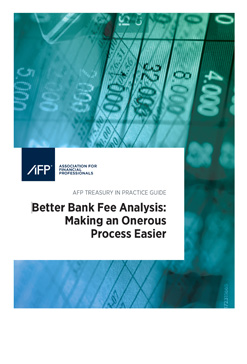Treasury relies heavily on the products and services offered by various financial service providers (FSPs), notably banks, and plays an important role in selecting FSPs and managing these relationships. This includes many responsibilities, such as day-to-day communication regarding transaction inquiries, performance evaluations and relationship reviews based on agreed-upon metrics and objectives. MORE.

Better Bank Fee Analysis: Making an Onerous Process Easier
2025 Commercial Account Analysis Benchmarks

The 2025 Commercial Account Analysis Benchmarks offers corporate treasurers top-tier fee benchmarks and valuable insights into bank pricing structures and profitability, enabling fair and effective bank relationship management.
AFP Service Codes

AFP Service Codes simplify treasury management by standardizing the analysis of bank fees and services for both domestic and global markets. These codes are available for purchase individually or as a bundled subscription, offering flexible solutions for efficient bank reporting.
Bank Scorecard

The AFP Bank Scorecard is your tool for comprehensive evaluation of your banking relationships. This tool uses qualitative and quantitative measures to capture critical feedback on services provided.

Treasury Management in Banking Series
Recent Articles
-
 Jun 12, 2025
Jun 12, 2025
Physical Accounts and Virtual Accounts Compared
There are some key differences between traditional physical bank accounts and virtual bank accounts. Specific functionalities vary between banks and according to the jurisdictions in which the virtual accounts are being used.Learn More -
 May 30, 2025
May 30, 2025
Achieving Enhanced Efficiency Gains Through Virtual Account Management
The initial adoption of virtual accounts typically leads to major efficiency gains, as multiple physical bank accounts are rationalized into a single virtual account management (VAM) network.Learn More -
 May 15, 2025
May 15, 2025
4 Best Practices for Virtual Account Management
Virtual accounts are highly flexible and are used by all types of companies, from single entity organizations through to multinational corporations. While the technology underpinning each solution is the same, the use cases vary significantly. However, there are still some best practices that all potential adopters can follow.Learn More
